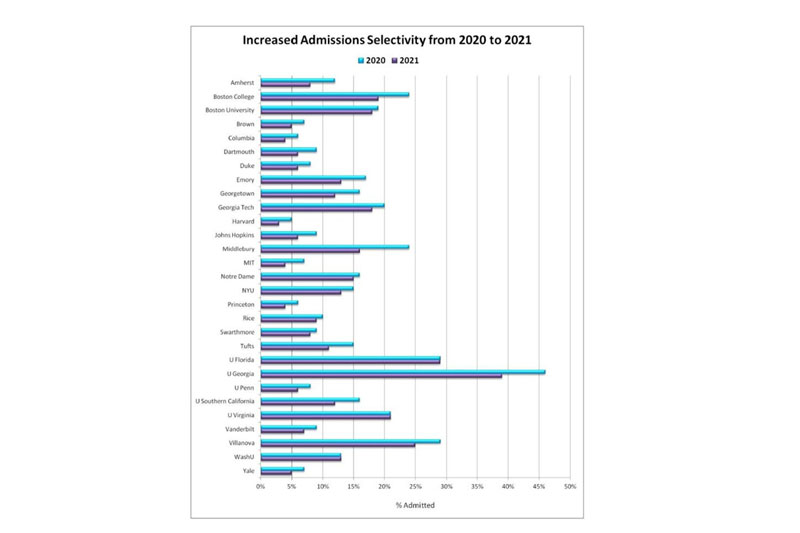2021 Admission Results & Insights
2021 proved to be one of the most competitive admissions years to date, with universities receiving a record number of applications.
However, we at Edvanta were fortunate to have the opportunity to guide and mentor incredible students, and together we achieved some outstanding admission results.
What can we learn from this most unusual admissions cycle? What new trends emerged and which are here to stay?
1. More applicants = Lower Admissions rates, Longer Waits
On the whole, highly sought after universities like the Ivies and other Top 30 universities saw a massive increase in the number of applications. This could be attributed to students and families seeing these institutions as a better way to hedge their bets against an uncertain future. With universities going test optional, many students who wouldn’t have considered applying in past years also decided to throw their hats in the ring, resulting in larger applicant pools, and smaller acceptance rates. (See graph below).
Students who applied to universities with rolling admissions (such as ones in the UK) also saw much longer wait times than in past years, as admissions offices waded their way through the increased volume of applications. Even now, some UK universities have yet to release all of their decisions!
With US universities remaining test optional, this trend is likely to continue. Elite universities will continue to see an increased number of applications, and will therefore become even more selective than in the past.
2. Importance of a balanced school list
An increasingly competitive admissions landscape means it’s even more important to have a balanced school list. Students should ensure that their list is a solid blend of elite, possible, and probable schools.
Universities’ Early Decision (ED) and Early Action (EA) acceptance rates saw a slight increase, as universities looked to these application plans as a form of yield protection. This year, the trend will remain the same – and it will be in a student’s interest to apply ED to a match or stretch (but not super-stretch) school, to improve their odds of admission.
3. Impact of test-optional
Universities will remain test-optional – but does test-optional mean the same thing at all schools?
Evidently not. For highly selective universities, standardized tests are still a way for high-achieving students to stand out.
For example, during the ED round, the University of Pennsylvania received 38% test optional applications, but only 24% of accepted students came from this category. At Georgetown (notoriously a stickler for standardized tests), less than 10% of students who applied test optional were admitted (overall acceptance rate was 14%).
This means that students still should plan to give standardized tests at least once, especially if they are targeting highly selective universities.
4. What stood out – Spiky & Gritty
The stats just shared above are not to say that applying test-optional means you won’t get in. Students did apply test-optional, and they did get into some of the best universities. So what made their applications stand out?
First of all, their academics. In lieu of standardized test scores, universities must rely more heavily on a student’s academic performance to evaluate their candidature. The importance of good grades cannot be overlooked.
Next, spiky profiles. This means students who may have been involved in several activities, but who had one to two major activities, awards, or aspects of their application that really stood out. There’s no “right” or “wrong” spike – it varies depending on the student. But what is important is that it demonstrates high achievement, and depth of commitment from the student.
Finally, universities were looking for grit. In the essays, they wanted to see students who had persevered, who had overcome obstacles, and who had demonstrated resilience, resourcefulness, and concern for others. These are qualities admissions officers always look for in candidates, but during this pandemic year, they seemed to resonate even more than in the past.


